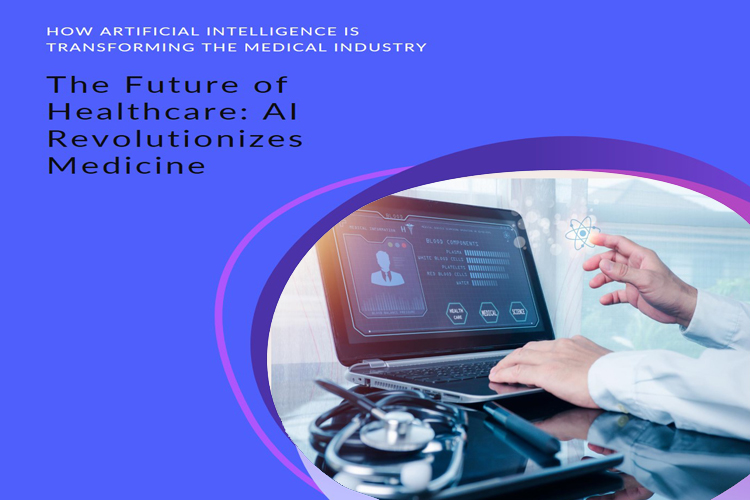A transformative exploration into the profound impact of AI on the healthcare industry
In recent years, the field of healthcare has witnessed an unprecedented transformation, fueled by remarkable advancements in artificial intelligence (AI). From diagnosis to treatment, AI has emerged as a game-changer that holds immense potential to revolutionize the way we approach healthcare. By seamlessly integrating human expertise with machine learning algorithms, this groundbreaking technology is propelling the industry forward, paving the way for faster, more accurate diagnoses, personalized treatments, and enhanced patient care.

Rethinking Diagnosis: AI as a Diagnostic Superpower
One of the most remarkable applications of AI in healthcare lies in its ability to augment and refine the diagnostic process. Traditionally, doctors have relied on their expertise and medical tests to identify diseases and conditions. However, AI algorithms are now stepping in as invaluable tools that can process vast amounts of patient data, analyze complex patterns, and generate accurate diagnoses in a fraction of the time. By harnessing the power of machine learning, AI can detect subtle nuances and indicators that even the most experienced human eye might miss, leading to more precise and timely detection of diseases like cancer, cardiovascular issues, and neurological disorders.
Personalizing Treatments: An Era of Tailored Medicine
Treatment plans that are tailored to individual patients' needs are becoming increasingly achievable, thanks to AI's ability to analyze vast volumes of healthcare data. By leveraging machine learning algorithms, AI can extract insights from patient records, genetic information, lifestyle data, and even wearable devices, enabling healthcare providers to develop personalized treatments. This groundbreaking approach not only enhances the efficacy of medical interventions but also minimizes side effects and improves patient outcomes. Furthermore, AI-powered systems can continuously monitor patients, providing real-time feedback and adjustments to treatment plans, elevating the level of care and reducing hospital readmissions.
Raising the Bar for Surgical Precision: Robotics and AI Join Forces
The integration of AI and robotics is empowering surgeons to perform intricate procedures more accurately than ever before. Surgeons can now rely on robotic systems equipped with AI algorithms to assist them during complex surgeries, offering unprecedented precision and control. These robotic surgical systems combine the dexterity of human hands with the analytical capabilities of AI, enabling minimally invasive procedures that reduce patient trauma, minimize recovery time, and improve surgical outcomes. As the technology advances, we can expect to see more sophisticated robotic surgical systems tackling increasingly complex surgeries, further enhancing patient safety and healthcare efficiency.
Pioneering the Future, Together: Collaborative Intelligence
The rise of AI in healthcare is not intended to replace medical professionals, but rather to enhance their capabilities. The human touch remains indispensable in healthcare, with empathetic patient care and critical decision-making still in the realm of human expertise. AI acts as an invaluable assistant, providing physicians with access to vast amounts of medical knowledge, augmenting their skills, and enabling more informed decision-making. By leveraging collaborative intelligence, the synergy between human expertise and AI-powered systems can redefine what is possible in healthcare, unlocking new levels of efficiency and effectiveness.
The Path Ahead: Challenges and Ethical Considerations
As AI reshapes the landscape of healthcare, it is crucial to address the challenges and ethical considerations that lie ahead. Protecting patient data privacy, ensuring the reliability and transparency of AI algorithms, and navigating the complexities of regulatory frameworks are some of the key hurdles that need to be overcome. Additionally, maintaining a balance between technological advancements and the need for human connection in healthcare remains a significant challenge.
Nevertheless, with careful navigation of these challenges and the responsible application of AI, the potential for enhancing healthcare is vast. As society embraces the transformative power of AI in healthcare, we move closer to a future where medical interventions are more precise, personalized, and accessible to all.
In conclusion, the advent of AI in healthcare represents a paradigm shift that promises to redefine the industry. By harnessing cutting-edge innovations, the field is undergoing a transformative journey towards more accurate diagnoses, personalized treatments, and improved patient care. Although challenges remain, the inspiring possibilities that lie ahead illustrate the immense potential of AI to shape a brighter future for healthcare. Let us embrace this exciting frontier, where the convergence of human expertise and artificial intelligence holds the key to reimagining medicine.

 The Future of Fiber Optic Communication Network Architecture: Evolution and the Role of SDON Technology
The Future of Fiber Optic Communication Network Architecture: Evolution and the Role of SDON Technology
 What opportunities and challenges does free-space optical communication technology face?
What opportunities and challenges does free-space optical communication technology face?
 Opelink MPO Products for High-Speed Data Center Applications
Opelink MPO Products for High-Speed Data Center Applications
 CWDM vs. DWDM: Which Optical Transmission Technology Should You Choose?
CWDM vs. DWDM: Which Optical Transmission Technology Should You Choose?